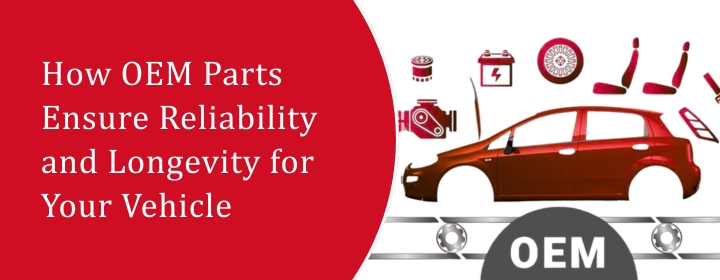
How OEM Parts Ensure Reliability and Longevity for Your Vehicle
You know how sometimes you try to save a little money by buying a cheaper car part and then, a few months later, you’re right back at the mechanic, wondering what went wrong? Yeah, we’ve been there too. It’s one of those lessons that hits you only after it costs you more in the long run. That’s usually when people start purchasing OEM parts.
Once you really get what OEM parts are — and why they matter — you start looking at car maintenance in a whole new light.
What OEM Parts Actually Are
OEM stands for Original Equipment Manufacturer. Basically, these are the exact same parts your car came with when it came out of the factory.
Same maker. Same specs. Same quality. It’s like your vehicle’s DNA — just in part form.
When you buy OEM parts, you’re not gambling. You know it’ll fit because it was literally made for your car. No weird tweaks, no “almost fits” that end up rattling a few weeks later.
We used to think the same as most people — that aftermarket parts are cheaper, so they must be the smarter option. But honestly, “cheaper” isn’t really cheaper when you have to replace something twice. At beelinesautomotive.com, we’ve seen plenty of folks come in frustrated after a low-cost part failed way too soon. Once they switched to OEM, though, their cars ran smoother and stayed that way.
Why OEM Parts Are Totally Worth It
Here’s what’s great about OEM parts — they’re consistent. Every single piece is made to match exact factory standards. It’s not “close enough.” It’s exactly right. That’s why most mechanics prefer them.
Reliability isn’t just about avoiding breakdowns — it’s about peace of mind. You don’t want to be driving down the highway wondering if your replacement alternator will hold up. With OEM parts, that worry gone. They’re tested, certified, and built to meet the manufacturer’s quality bar.
And if we’re talking longevity — well, that’s where they really shine. OEM parts don’t fight against your car’s system. They blend right in, so nothing’s straining or compensating. That means less wear over time.
You Can Actually Feel the Difference
Something we’ve noticed: when people switch from aftermarket to OEM, it’s rarely dramatic at first — but after a week or two, they start saying things like, “The engine sounds quieter,” or “My steering feels tighter now.” Those small changes? That’s OEM precision at work.
See, aftermarket parts are made to fit multiple vehicles. And while they might work fine, little mismatches happen — a sensor might misread, or a seal might not sit perfectly. Over time, that adds up. OEM parts, on the other hand, are laser-cut for one vehicle, one function. That’s why everything suddenly feels more “in sync.”
At beelinesautomotive.com, we always tell people — comfort and safety shouldn’t depend on guesswork. That’s why we recommend OEM every single time.
Clearing Up Some Myths About OEM Parts
- “They’re too expensive.” Yes, OEM parts can look costly at first glance. But once you figure out how long they last and how well they perform, the cost difference decreases. Because you are paying for dependability and not for a fancy name.
- “Aftermarket parts are just as good.” Sometimes they are. But not always. Even small differences in design can affect performance.
- “They are difficult to find.” That used to be true years ago. Now, it’s super easy. You can hop onto websites like beelinesautomotive.com and find OEM parts for pretty much any make or model. Order, compare, done — no hunting around at local shops.
Why Reliability Matters So Much Today
Modern vehicles aren’t as simple as they used to be. Every system component, from fuel injectors to transmission sensors, connects with the others. So when one part fails to function properly, it affects the entire system.
Therefore, using genuine OEM parts matters a lot. They’re made to maintain your car’s original engineering harmony. And beyond performance, it’s also about safety. You don’t want to find out your braking system’s acting up because of an off-brand part that didn’t quite match. OEM minimizes that risk.
The Long Game: Why OEM Wins
Here’s something we’ve learned over time — reliability and longevity don’t come from shortcuts. They come from choosing what’s built to last. OEM parts are exactly that.
When you replace something with an OEM part, you’re not just fixing a problem. You’re protecting the rest of your car, too. It’s like strengthening the foundation instead of patching a wall.
One reliable replacement now means fewer surprises later — fewer breakdowns, fewer “why’s my check engine light on again?” moments.
whereas, if you are unsure, you can try it just one time. What you can do is just replace one crucial part, suppose, a water pump or brake pads, with OEM instead of aftermarket. You will probably notice the difference sooner than you expect.
Final Thoughts
OEM parts aren’t about being fancy or overpriced — they’re about being right. They are the perfect fit for your vehicle. So, they can perform just like they are the originals. Henceforth, if you really want your vehicle to run smoothly and efficiently, then you should choose OEM parts for your vehicle.
Rest, you can check out at beelinesautomotive.com. We have got extensive range of OEM parts built for performance and reliability.
At the end of the day, the original really is the best — especially when you want your car to run like the day it left the factory.